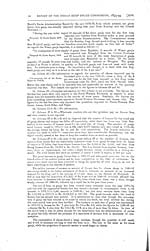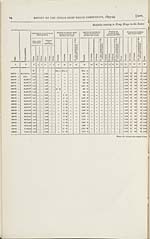Medicine - Drugs > Report of the Indian Hemp Drugs Commission, 1894-1895 > Volume III
(17) Volume 3, Page 13
Thumbnail gallery: Grid view | List view

BENGAL MEMORANDUM. 13
The great increase in the
consumption of bhang is more apparent than real, and is due
to larger use of the duty-paid drug.
60. The
importance of hemp-drugs in these provinces will be apparent from
the
fact that out of a total excise revenue of 115 lakhs in 1892-93,
ganja and its congeners con-
tributed 241/4 lakhs, or about 21 per cent., and occupy the second
place, being next only to
country spirits. Of the four varieties that are taxed, ganja,
bhang, charas, and majum, ganja
alone yielded more than 233/4 lakhs. The revenue from majum, a
sweet preparation of bhang
in the form of confection, is insignificant, being under Rs. 2,000.
The consumption of
majum is practically confined to Calcutta, Patna, and Cuttack. The
revenue from charas was
under Rs. 10,000. It is consumed in the urban areas of a few
districts in Central and West-
ern Bengal. The revenue from bhang exceeded half a lakh. Its
consumption is general,
and the quantity (1,034 maunds) that paid duty represents but a
small fraction of what was
illicitly consumed.
61. The
cultivation and manufacture of Rajshahi ganja that not only
supplies the Lower
Provinces, but is also exported to Assam, Nepal, North-Western
Provinces, &c., is confined
to a small well-marked area. It is a paying crop, and a year of
good prices usually leads
to extended cultivation in the next. From the time the drug is
brought to the Naogaon
head office, to be weighed, packed, and despatched to the consuming
districts, the safeguards
against fraud provided by the existing rules appear to be ample,
and it may be safely affirmed
that there is little room for evasion of duty during transit or in
the subsequent stages, includ-
ing storage in golas, issue to retail vendors and sale to
consumers. There is likewise good
reason to think that there is no unlicensed cultivation, and that
no ganja is made for the
market outside the recognized tract.
62. The weak
points of the system may be said to be all connected with the
process of
manufacture and the storage of the drug in private golas prior to
disposal to wholesale
dealers. Manufacture begins simultaneously at different places, and
its progress is not
watched as closely as it ought to be. The outturn is not checked
then and there, but a
rough estimate is subsequently made by merely counting the number
of bundles of each sort,
which can hardly supply the place of an accurate weighment. Then
the drug is stored in
private houses, in mere sheds which are sometimes open and always
insecure, and there is
ample opportunity for petty pilfering by outsiders, even supposing
the cultivators were all
above suspicion.
63. The difficulty
of working a scheme of public golas without a Government
monopoly
has been adverted to under section (c). In the case of opium
the cultivator sells his produce
outright to Government at a fixed price and has no further concern
with it. The entire
quantity purchased from the different cultivators is dealt with as
one stock. In the case of
ganja, however, the drug remains the cultivator's property and in
his charge until he dis-
poses of it to a licensed purchaser. It has therefore been found
impracticable to introduce
public warehouses where all the drug could be stored immediately
after manufacture. In
view of the attacks made against the Government monopoly in opium,
it is not likely that
any proposal to establish a similar monopoly in ganja would be
received with favour. But with
a larger establishment the existing checks on manufacture might be
rendered more effective.
64. Four sorts of ganja
are now made, flat large twigs, flat small twigs, round, and
choor,
and these distinctions are observed for the levy of duty and for
the purposes of the wholesale
trade but no twigs or woody matter are taken by the retail
purchaser, and for retail sale the
other varieties are also reduced to choor by the retail vendor. It
would therefore be a good plan
to have only one sort and abolish flat and round. Particular
localities are said to favour par-
ticular sorts, but the fact that the consumption of choor increased
very largely (from 424
maunds to 1,369 maunds) during the past year owing to the discovery
that it was more
lightly taxed in proportion to the amount of narcotic matter
present in it, would seem to
show that there can be no great objection to its general adoption.
To the wholesale dealer
this would reduce cost of carriage and save storage room; to
Government it would simplify
accounts, and remove all chances of fraud to revenue for which
differential rates afford some
room.
65. The cost
of daily average allowance of ganja is 3 to 6 pies, while the cost
of liquor to
the habitual consumer is much higher. The cost of liquor is almost
prohibitive to the poorer
classes in Eastern and Central Bengal, but even in Bihar, where
liquor is cheap, the daily
cost is seldom less than 9 to 12 pies. In this view ganja may be
said to be insufficiently
taxed. Competition, however, is annually raising the license fees,
and the duty is also
enhanced from time to time.
66. Under the
present system the wholesale dealers (goladars) make very large
profits in
some districts. They pay no license fees and combine to create a
monopoly. It would per-
haps be a better plan to recognize the monopoly, but to obviate its
evil effects by fixing a
maximum price for sales to retail vendors. Government might also
appropriate a portion of
the profits by giving the wholesale license for a given area to the
person who agreed to pay
the largest amount for each seer sold, in addition to the
duty.
CALCUTTA; K. G. GUPTA,
The 27th November 1893. Commissioner of Excise, Bengal.
4
Set display mode to: Large image | Zoom image | Transcription
Images and transcriptions on this page, including medium image downloads, may be used under the Creative Commons Attribution 4.0 International Licence unless otherwise stated. ![]()
| India Papers > Medicine - Drugs > Report of the Indian Hemp Drugs Commission, 1894-1895 > Volume III > (17) Volume 3, Page 13 |
|---|
| Permanent URL | https://digital.nls.uk/74551744 |
|---|---|
| Description | Bengal memorandum, cont. |
| Description | Volume 3: Appendices. Miscellaneous. |
|---|---|
| Attribution and copyright: |
|




